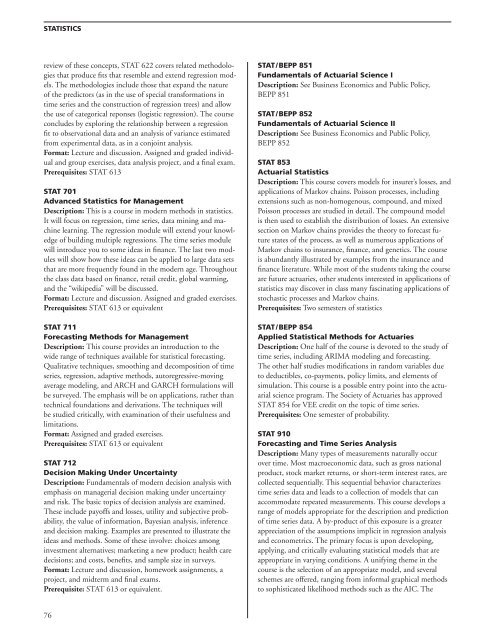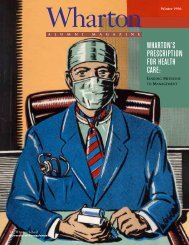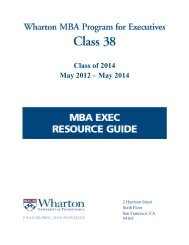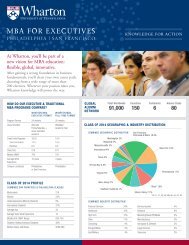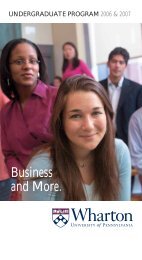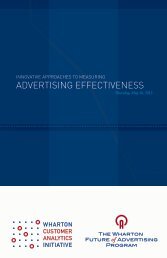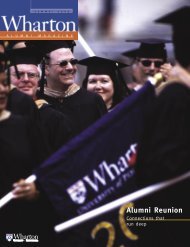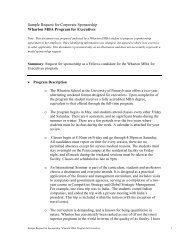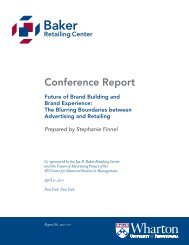Explore Options; Plan Your MBA Academic Program
Explore Options; Plan Your MBA Academic Program
Explore Options; Plan Your MBA Academic Program
You also want an ePaper? Increase the reach of your titles
YUMPU automatically turns print PDFs into web optimized ePapers that Google loves.
STATISTICS<br />
review of these concepts, STAT 622 covers related methodologies<br />
that produce fits that resemble and extend regression models.<br />
The methodologies include those that expand the nature<br />
of the predictors (as in the use of special transformations in<br />
time series and the construction of regression trees) and allow<br />
the use of categorical reponses (logistic regression). The course<br />
concludes by exploring the relationship between a regression<br />
fit to observational data and an analysis of variance estimated<br />
from experimental data, as in a conjoint analysis.<br />
Format: Lecture and discussion. Assigned and graded individual<br />
and group exercises, data analysis project, and a final exam.<br />
Prerequisites: STAT 613<br />
STAT 701<br />
Advanced Statistics for Management<br />
Description: This is a course in modern methods in statistics.<br />
It will focus on regression, time series, data mining and machine<br />
learning. The regression module will extend your knowledge<br />
of building multiple regressions. The time series module<br />
will introduce you to some ideas in finance. The last two modules<br />
will show how these ideas can be applied to large data sets<br />
that are more frequently found in the modern age. Throughout<br />
the class data based on finance, retail credit, global warming,<br />
and the “wikipedia” will be discussed.<br />
Format: Lecture and discussion. Assigned and graded exercises.<br />
Prerequisites: STAT 613 or equivalent<br />
STAT 711<br />
Forecasting Methods for Management<br />
Description: This course provides an introduction to the<br />
wide range of techniques available for statistical forecasting.<br />
Qualitative techniques, smoothing and decomposition of time<br />
series, regression, adaptive methods, autoregressive-moving<br />
average modeling, and ARCH and GARCH formulations will<br />
be surveyed. The emphasis will be on applications, rather than<br />
technical foundations and derivations. The techniques will<br />
be studied critically, with examination of their usefulness and<br />
limitations.<br />
Format: Assigned and graded exercises.<br />
Prerequisites: STAT 613 or equivalent<br />
STAT 712<br />
Decision Making Under Uncertainty<br />
Description: Fundamentals of modern decision analysis with<br />
emphasis on managerial decision making under uncertainty<br />
and risk. The basic topics of decision analysis are examined.<br />
These include payoffs and losses, utility and subjective probability,<br />
the value of information, Bayesian analysis, inference<br />
and decision making. Examples are presented to illustrate the<br />
ideas and methods. Some of these involve: choices among<br />
investment alternatives; marketing a new product; health care<br />
decisions; and costs, benefits, and sample size in surveys.<br />
Format: Lecture and discussion, homework assignments, a<br />
project, and midterm and final exams.<br />
Prerequisite: STAT 613 or equivalent.<br />
76<br />
STAT / BEPP 851<br />
Fundamentals of Actuarial Science I<br />
Description: See Business Economics and Public Policy,<br />
BEPP 851<br />
STAT / BEPP 852<br />
Fundamentals of Actuarial Science II<br />
Description: See Business Economics and Public Policy,<br />
BEPP 852<br />
STAT 853<br />
Actuarial Statistics<br />
Description: This course covers models for insurer’s losses, and<br />
applications of Markov chains. Poisson processes, including<br />
extensions such as non-homogenous, compound, and mixed<br />
Poisson processes are studied in detail. The compound model<br />
is then used to establish the distribution of losses. An extensive<br />
section on Markov chains provides the theory to forecast future<br />
states of the process, as well as numerous applications of<br />
Markov chains to insurance, finance, and genetics. The course<br />
is abundantly illustrated by examples from the insurance and<br />
finance literature. While most of the students taking the course<br />
are future actuaries, other students interested in applications of<br />
statistics may discover in class many fascinating applications of<br />
stochastic processes and Markov chains.<br />
Prerequisites: Two semesters of statistics<br />
STAT / BEPP 854<br />
Applied Statistical Methods for Actuaries<br />
Description: One half of the course is devoted to the study of<br />
time series, including ARIMA modeling and forecasting.<br />
The other half studies modifications in random variables due<br />
to deductibles, co-payments, policy limits, and elements of<br />
simulation. This course is a possible entry point into the actuarial<br />
science program. The Society of Actuaries has approved<br />
STAT 854 for VEE credit on the topic of time series.<br />
Prerequisites: One semester of probability.<br />
STAT 910<br />
Forecasting and Time Series Analysis<br />
Description: Many types of measurements naturally occur<br />
over time. Most macroeconomic data, such as gross national<br />
product, stock market returns, or short-term interest rates, are<br />
collected sequentially. This sequential behavior characterizes<br />
time series data and leads to a collection of models that can<br />
accommodate repeated measurements. This course develops a<br />
range of models appropriate for the description and prediction<br />
of time series data. A by-product of this exposure is a greater<br />
appreciation of the assumptions implicit in regression analysis<br />
and econometrics. The primary focus is upon developing,<br />
applying, and critically evaluating statistical models that are<br />
appropriate in varying conditions. A unifying theme in the<br />
course is the selection of an appropriate model, and several<br />
schemes are offered, ranging from informal graphical methods<br />
to sophisticated likelihood methods such as the AIC. The


